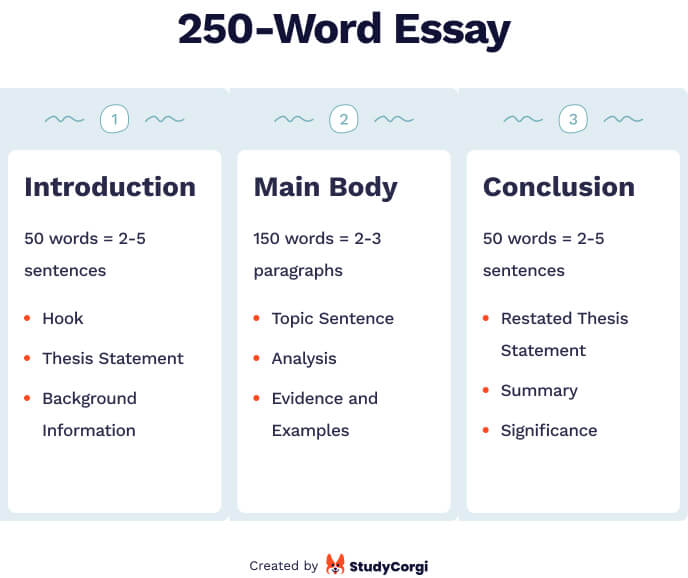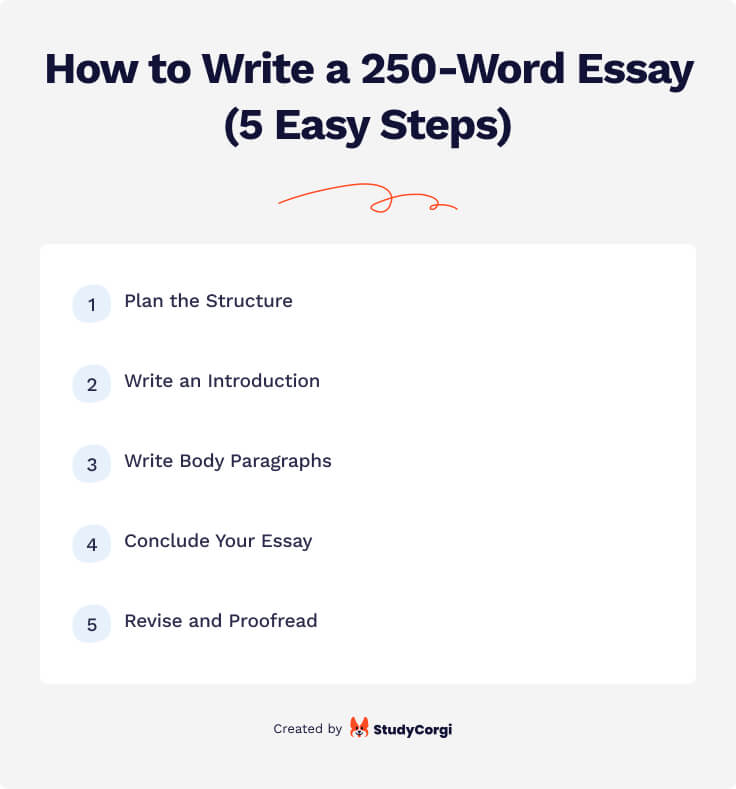A 250-word essay is a frequently used format for scholarship and college applications. At the same time, students can be assigned to write such a paper in a classroom to express their thoughts on some topic in a concise yet impactful manner. If you are troubled with condensing your ideas into 250 words—don’t worry; we have your back!
This article will reveal the essential aspects of structuring a short essay. Here, you’ll find the answers to the following questions:
- What does a 250-word essay look like?
- How many paragraphs fit in 250 words?
- How to write a 250-word essay for a scholarship?
Besides this fundamental information, we offer you excellent samples written by your fellow students. Why This College essay 250-word example, a paper on Why I Want to Be a Nurse, and many other pieces are at your service!
📝 What Does a 250-Word Essay Look Like
Some students find a 250-word essay challenging because they’re confused about its structure and formatting. To simplify this assignment for you, we’ve made outlines for various types of 250-word essays.

250 Word Essay Outline
A 250-word essay captures the topic’s essence within a restricted word count. It usually comprises an introduction, body paragraphs, and a conclusion. Each section is pivotal in the paper’s length, making every word count.
- Introduction (about 50 words or 2-5 sentences). It presents the central idea, includes a thesis statement, and catches readers’ attention.
- Body (about 150 words for 2-3 paragraphs). It elaborates on your core points and provides proof.
- Conclusion (about 50 words). This part recaps the central points and incorporates a rephrased thesis.
Now, let’s look at general outlines for distinct essay types.
Definition Essay
A definition essay explains the meaning of your selected term or concept. It’s often composed in response to questions like “Define X” or “What is an X?”
Below is a model outline for a 250-word definition essay.
Introduction
- A short standard definition of the term.
- Context.
- A thesis with your definition and viewpoint about the concept.
Body
Clarify your term definition using these strategies:
- Compare the notion to similar ones.
- State what the term is not.
- Illustrate it with examples.
- Break it down into parts.
Conclusion
- Paraphrased thesis.
- Summarized key points.
- A closing statement.
Analytical Essay
An analytical essay answers questions like “Analyze X” or “What are the components of X?” You may examine and interpret a piece of literature, artwork, or any other subject.
Here’s a classic analytical essay plan.
Introduction
- An attention-grabbing sentence.
- Background information.
- A thesis statement outlining what you’ll investigate and how.
Body
- A topic sentence linked to the thesis.
- Proof (quotes, theory, etc.)
- Analysis of the evidence.
- Transition to the next idea.
Conclusion
- Reworded thesis.
- The significance or broader implications of the analyzed topic.
Cause & Effect Essay
A cause-and-effect paper explores the link between events or phenomena. It typically answers questions like “What are the root causes of X?” or “What led to X?”
An outline for this essay is shown below.
Introduction
- The context of the chosen issue.
- A thesis statement clarifying the cause-and-effect relationship.
Body
- A topic sentence stating the cause or consequence.
- Supporting evidence.
- Transition sentence to another cause/effect.
Conclusion
- Rephrased thesis.
- A recap of the primary points.
Compare & Contrast Essay
A compare and contrast essay investigates the similarities and distinctions between two or several subjects. It answers questions like “How does X differ from Y?” or “Compare X and Y.”
Check out a possible outline for such a paper.
Introduction
- Background information on the objects of comparison.
- A thesis statement stating the identified parallels and differences between the compared items.
Body
Organize your body in one of these ways:
- Point-by-point method:
- Area of comparison 1
- Item A
- Item B
- Area of comparison 2
- Item A
- Item B
- Block method:
- Object A
- Aspect of comparison 1
- Aspect of comparison 2
- Object B
- Aspect of comparison 1
- Aspect of comparison 2
Conclusion
- Summary of main points.
- Evaluation of similarities and contrasts.
- Significance of the topic.
Process Essay
A process essay clarifies how to perform some task or how something works. It responds to prompts like “List the steps involved in X” or “Explain what happened in X.”
In this paper, chronologically arranging your discussion is a must. Here’s an outline example you can use.
Introduction
- Background information—a scenario of where the process can be essential.
- A thesis statement indicating the number of steps needed and the purpose of knowing them.
Body
- Description of step 1 (materials, procedures, and tips).
- Description of step 2.
- Description of step 3.
Conclusion
- Reference to the opening scenario and purpose.
- Description of the process result.
- A closing statement.
Argumentative Essay
An argumentative essay introduces your stance on a debatable topic and supports it with evidence and reasoning. It usually centers around a prompt like “A famous person said X. Do you agree or not?”
A standard outline for a persuasive essay looks as shown below.
Introduction
- Context of the problem.
- A thesis statement indicating the standpoint being argued.
Body
- Argument 1 with supporting evidence.
- Argument 2 with supporting details.
- Counterargument and refutation.
Concluding paragraph
- Reworded thesis statement.
- Summary of central points.
250 Word Essay Format
Even though a 250-word essay is short, you should still format it according to the academic requirements. Here are the main ones:
- Font style. Avoid using fancy fonts, as they may be difficult to read. Instead, opt for standard fonts used in academic writing—Times New Roman or Arial. The default font provided by MS Word, Calibri, is also perfectly acceptable.
- Font size. It should be 11 or 12 points.
- Margins. Set margins to 1 inch (2.54 cm) on all sides.
- Line spacing. As a rule, professors expect papers to be double-spaced.
- Alignment. Your essay should be left-aligned: it looks neater than fully justified.
- Indents. Indent the first line of your paragraphs.
- Reference List. Format your references according to your citation style requirements (MLA, APA, Chicago, or Harvard).
250 Word Essay Length

A 250-word essay is approximately 1 double-spaced or 0.5 single-spaced pages. However, the paper’s length can vary depending on the margins, font size, and spacing. If you’re uncertain about your paper’s formatting requirements, consider consulting your professor.
✅ How to Write a 250-Word Essay
At first, writing a 250-word essay may seem challenging, but following these steps can help you effectively organize your thoughts and compose a concise and compelling paper.

1. Plan the Structure
Carefully read and decipher the essay prompt. Your goal here is to identify the central question you should cover in your essay. Then, create an outline—it’ll help you avoid exceeding the word count. Decide on the key points you’ll discuss and their order.
2. Write the Introduction
Start with a hook that captures readers’ attention. Then, briefly review the topic. For instance, you can point out the subject’s significance or introduce key terms necessary to understand your essay. Finally, develop a thesis statement—a sentence encapsulating the core message of your writing.
3. Write the Body
Develop your main points in separate paragraphs. It’s best to start each with a topic sentence expressing the paragraph’s main idea. Use evidence, examples, or research data to support your points. If you refer to any sources in your writing, remember to cite them properly to avoid plagiarism.
4. Conclude Your Essay
To conclude your paper, remind readers of your central idea by rewording the thesis statement. Then, recap all the main points and emphasize the significance of the discussed issue. You can also add a thought-provoking message, a call to action, or a suggestion for further exploration.
5. Revise and Proofread
Review your draft for clarity, coherence, and errors. See if your thoughts are well-organized and to the point. Check for any repetitive or unessential details and remove them. Also, ensure your paper adheres to the formatting instructions supplied by your teacher.
🌟 250 Word Scholarship Essay: Writing Prompts
A 250-word writing is a standard format for scholarship and college applications. For your inspiration, we collected some 250-word essay scholarship examples. See them below!
📃 250-word Essay on Why I Deserve a Scholarship
In a 250-word essay on why you deserve a scholarship, you can emphasize your achievements, goals, and aspirations that make you a suitable candidate for financial support. Here are some points to cover:
- Educational attainment. Discuss your academic performance, including honors, awards, or other achievements.
- Personal accomplishments. Share any achievements demonstrating your character, leadership skills, or commitment to making a positive impact.
- Future impact. Clarify how the bursary will enable you to contribute to society through research, innovation, community service, or other means.
📃 Why This College Essay: 250 Words Examples
In a “Why this college” essay, you explain why you wish to attend a given educational establishment. There are lots of points you can incorporate into the body of your 250-word essay:
- Academic fit. Discuss how the selected study program aligns with your educational interests and ambitions.
- Campus culture and community. Elaborate on how the school’s campus culture and student organizations resonate with you.
- Personal connection. Recount your interactions with the college or its community. It may involve visiting the campus, participating in events, or engaging with current students or alumni.
📃 250 Word Essay on Why I Want to Be a Nurse
In a 250-word essay explaining your career choice, you should be authentic and sincere. Share personal experiences or realizations demonstrating your passion for the selected field. Here are some ideas for your “Why I want to be a nurse” essay:
- Personal experiences. Discuss any experiences that have influenced your desire to become a nurse.
- Compassion and empathy. Highlight your natural inclination toward caring for others and your ability to empathize with those in need.
- Interest in healthcare. Share your passion for medicine and how nursing aligns with your desire to promote well-being.
📃 Life Changing Experience Essay: 250 Words
In a 250-word “life-changing experience” essay, you can describe an event that influenced your life and altered your perspective, values, or goals. Here are some points to include:
- Introduction. Present the experience and explain its significance.
- Description. Describe the event, focusing on your emotions and thoughts.
- Lessons learned. Share the insights you gained from the experience. What did you learn about yourself, others, or the world?
How to Write a 250-Word Essay for a Scholarship?
When writing a 250-word scholarship essay, you should take your time, be authentic, and ensure your paper reflects your true self. Start as soon as possible to have enough time before the application deadline. When brainstorming ideas, review other scholarship essay examples. Don’t hesitate to ask other people for feedback and help with proofreading.
📖 Essay 250 Words: Example
If you’re still wondering how to write a concise but meaningful paper, check out our 250-word social media essay example.
The role of social media in spreading fake news has become a pressing concern nowadays. With the rising popularity of platforms like Facebook and Twitter, information can spread rapidly, regardless of its trustworthiness and correctness. This paper will investigate how social media contributes to disseminating deceptive information.
One primary reason social networks are a breeding ground for fake news is their capacity to reach a vast audience within seconds. With minimal entry barriers, such platforms enable anyone to share information regardless of its truthfulness. Thus, individuals with ill intentions can effortlessly distribute falsehoods among unsuspecting users.
Additionally, social media algorithms can amplify fake news. They prioritize content that receives high engagement levels, such as likes, shares, and comments. Consequently, controversial content frequently receives more publicity, even if it lacks credibility.
To deal with spreading false news on social media, platforms must take accountability by enforcing stricter policies, implementing fact-checking measures, and promoting reliable sources. It is also vital to equip users with tools to authenticate data before sharing it to prevent the proliferation of distorted information on social networks.
Social media undoubtedly contributes to spreading false news due to its expansive reach, algorithmic biases, and echo chamber effect. It is paramount for people to be critical consumers of content and for social media platforms to tackle this issue proactively.
🤓 250 Words Essay Topics
A 250-word essay can cover various topics, depending on the assignment’s purpose and requirements. Here we’ve gathered some interesting ideas you can use for your paper:
- How does social media influence people’s self-esteem?
- Obesity and its effect on human health.
- Is animal testing ethical?
- Vaccines for kids: pros and cons.
- How does motivation affect people’s life and success?
- The social significance of wearing school uniforms.
- How safe is GMO food?
- The history of hip-hop music.
- The importance of promoting fair labor policies.
- Ways to prevent domestic violence.
- Various forms of dance and their cultural significance.
- The cultural importance of Renaissance art.
- How does the family environment affect students’ academic success?
- Homeschooling: pros and cons.
- How would you define success?
- Best ways to deal with stress.
- Should kindergartens be more literacy-based or play-based?
- How does pop culture affect teenagers?
- How do physical exercises influence mental health?
- The importance of family values.
- Urological Disorders in the Older Adult.
- Probiotics Use by a Patient on Antibiotics.
